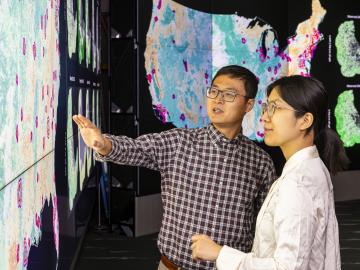Filter News
Area of Research
- Advanced Manufacturing (3)
- Biology and Environment (19)
- Clean Energy (22)
- Computational Biology (2)
- Computational Engineering (2)
- Computer Science (6)
- Electricity and Smart Grid (1)
- Functional Materials for Energy (1)
- Fusion and Fission (2)
- Fusion Energy (1)
- Materials (41)
- Materials for Computing (5)
- National Security (17)
- Neutron Science (102)
- Nuclear Science and Technology (5)
- Supercomputing (77)
News Topics
- (-) Artificial Intelligence (84)
- (-) Neutron Science (128)
- (-) Summit (57)
- 3-D Printing/Advanced Manufacturing (116)
- Advanced Reactors (33)
- Big Data (50)
- Bioenergy (88)
- Biology (95)
- Biomedical (57)
- Biotechnology (21)
- Buildings (54)
- Chemical Sciences (59)
- Clean Water (29)
- Climate Change (94)
- Composites (25)
- Computer Science (182)
- Coronavirus (46)
- Critical Materials (24)
- Cybersecurity (35)
- Decarbonization (73)
- Education (3)
- Element Discovery (1)
- Emergency (2)
- Energy Storage (106)
- Environment (192)
- Exascale Computing (34)
- Fossil Energy (5)
- Frontier (39)
- Fusion (52)
- Grid (59)
- High-Performance Computing (82)
- Hydropower (11)
- Irradiation (3)
- Isotopes (46)
- ITER (7)
- Machine Learning (44)
- Materials (140)
- Materials Science (133)
- Mathematics (6)
- Mercury (12)
- Microelectronics (2)
- Microscopy (50)
- Molten Salt (8)
- Nanotechnology (60)
- National Security (56)
- Net Zero (11)
- Nuclear Energy (103)
- Partnerships (40)
- Physics (58)
- Polymers (31)
- Quantum Computing (28)
- Quantum Science (65)
- Renewable Energy (2)
- Security (23)
- Simulation (43)
- Software (1)
- Space Exploration (24)
- Statistics (3)
- Sustainable Energy (119)
- Transformational Challenge Reactor (7)
- Transportation (93)
Media Contacts

Scientists at ORNL completed a study of how well vegetation survived extreme heat events in both urban and rural communities across the country in recent years. The analysis informs pathways for climate mitigation, including ways to reduce the effect of urban heat islands.

The new section of tunnel will provide the turning and connecting point for the accelerator beamline between the existing particle accelerator at ORNL’s Spallation Neutron Source and the planned Second Target Station, or STS. When complete, the PPU project will increase accelerator power up to 2.8 megawatts from its current record-breaking 1.7 megawatts of beam power.

Groundbreaking report provides ambitious framework for accelerating clean energy deployment while minimizing risks and costs in the face of climate change.

Scientists at Oak Ridge National Laboratory and six other Department of Energy national laboratories have developed a United States-based perspective for achieving net-zero carbon emissions.
Simulations performed on the Summit supercomputer at ORNL are cutting through that time and expense by helping researchers digitally customize the ideal alloy.

Thomas Proffen, a neutron scattering scientist at ORNL and founder of Oak Ridge Computer Science Girls, was recognized with an award from the National Center for Women & Information Technology, or NCWIT. In addition, one of his students received a national honor from the organization.

Held in Cocoa Beach, Florida from March 11 to 14, researchers across the computing and data spectra participated in sessions developed by staff members from the Department of Energy’s Oak Ridge National Laboratory, or ORNL, Sandia National Laboratories and the Swiss National Supercomputing Centre.

An international team using neutrons set the first benchmark (one nanosecond) for a polymer-electrolyte and lithium-salt mixture. Findings could produce safer, more powerful lithium batteries.
The Neutron Scattering Society of America, or NSSA, recognized Oak Ridge National Laboratory’s Ke An and Ken Herwig as fellows for their outstanding contributions to neutron scattering.

In the age of easy access to generative AI software, user can take steps to stay safe. Suhas Sreehari, an applied mathematician, identifies misconceptions of generative AI that could lead to unintentionally bad outcomes for a user.




